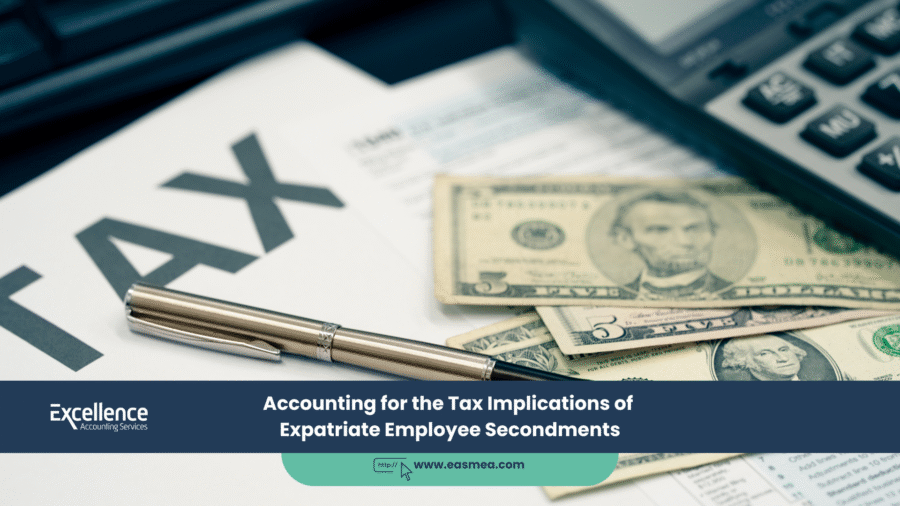Accounting for the Tax Implications of Expatriate Employee Secondments
In a globalized economy, mobilizing talent across borders is a key strategy for growth. Multinational corporations and ambitious local firms in the UAE frequently use employee secondments—temporarily assigning an employee to another country—to transfer skills, manage international projects, and develop future leaders. While strategically beneficial, seconding an employee into or out of the UAE creates a minefield of complex tax and accounting challenges.
The arrangement, which seems simple on the surface, triggers a host of critical questions: Which country has the right to tax the employee’s salary? Does the employee’s presence create a “Permanent Establishment” (PE) for the home country company, exposing it to UAE Corporate Tax? How are the costs of the secondment allocated and priced between the two entities? Getting the answers wrong can lead to unexpected tax liabilities, regulatory penalties, and significant administrative burdens.
This guide provides a framework for finance and HR departments on how to account for the tax implications of expatriate secondments. We will delve into the critical concepts of Permanent Establishment, transfer pricing, and payroll obligations, ensuring your international mobility program is both strategic and compliant.
Key Takeaways
- Permanent Establishment (PE) Risk is Paramount: The presence of a seconded employee in the UAE could inadvertently create a taxable presence for the foreign parent company.
- Substance Over Form: Tax authorities look at the economic reality of the arrangement. The details of who controls the employee’s work and bears the risk are more important than the wording of the secondment agreement.
- Transfer Pricing Rules Apply: The cost of the seconded employee must be recharged to the UAE entity at an “arm’s length” price, as if the two entities were unrelated.
- Payroll and Social Security are Complex: Determining where to pay salary, withhold taxes (if any), and make social security contributions requires careful analysis of tax treaties and local laws.
- Documentation is Your Defense: A clear, comprehensive secondment agreement and robust transfer pricing documentation are your best defense against challenges from tax authorities.
The Core Tax & Accounting Challenges of Secondments
A secondment arrangement involves three parties: the home entity (the original employer), the host entity (the company in the new country), and the employee. The financial relationships between them are what tax authorities scrutinize.
1. Permanent Establishment (PE) Risk
This is often the most significant risk. A PE is a fixed place of business through which the business of an enterprise is wholly or partly carried on. According to the OECD Model Tax Convention, the presence of an employee in another country can create a PE if they have, and habitually exercise, an authority to conclude contracts in the name of the foreign enterprise. If a PE is created, the profits attributable to that PE can be taxed in the host country. For a foreign company seconding an employee to the UAE, this could trigger a UAE Corporate Tax liability.
2. Payroll, Withholding, and Individual Tax
While the UAE does not currently have a federal personal income tax, the question of where payroll is managed is crucial.
- Host Country Payroll: If the UAE entity pays the employee directly, it simplifies local compliance but requires setting up a local payroll.
- Home Country Payroll (Recharge): Often, the employee remains on the home country payroll for continuity of benefits. The home entity then “recharges” the full cost to the UAE entity. This is where transfer pricing becomes critical.
The employee’s home country may still have tax obligations, and the secondment’s structure can impact this.
3. Transfer Pricing and the Arm’s Length Principle
When the home entity recharges the cost of the employee to the UAE host entity, this is a related-party transaction. UAE’s transfer pricing rules require this recharge to be at “arm’s length”—the price that would have been charged between two independent companies. This means you must:
- Identify all costs: This includes salary, bonus, benefits, housing allowance, school fees, and a portion of the home entity’s overhead.
- Apply a markup: Often, a markup (e.g., 5-10%) is added to the total cost to represent a profit element for the service of providing a skilled employee.
- Prepare Documentation: You must maintain transfer pricing documentation to justify how you arrived at the recharge amount. Our guide on transfer pricing explains this in more detail.
In a secondment, the legal documents must align with the economic reality. If the UAE entity directs and controls the employee’s work, it should bear the full, arm’s-length cost of that employee.
What Excellence Accounting Services (EAS) Can Offer
Managing the tax and accounting complexities of international secondments requires specialized knowledge. Excellence Accounting Services provides end-to-end support for your global mobility programs.
- Secondment Structure Advisory: We provide business consultancy to help you design secondment agreements that are tax-efficient and minimize the risk of creating a Permanent Establishment.
- Transfer Pricing Services: Our team helps you develop a compliant transfer pricing policy for recharging secondment costs, including preparing the necessary documentation to defend your position.
- Expatriate Payroll Management: We can manage the complexities of expatriate payroll, whether it’s setting up a host country payroll in the UAE or advising on a recharge mechanism.
- Tax Compliance & Advisory: We assess the Corporate Tax and VAT implications of your secondment arrangements, ensuring full compliance with Federal Tax Authority (FTA) regulations.
- Liaison with Legal and HR: We work seamlessly with your legal and HR consultancy teams to ensure that employment contracts, visa requirements, and secondment policies are all aligned from a financial and tax perspective.
Frequently Asked Questions (FAQs)
The main factor is typically the authority to conclude contracts. If the seconded employee is a senior manager who is negotiating and signing contracts with UAE customers on behalf of the foreign parent company, this creates a very high PE risk.
This is an arrangement where the employee has two separate employment contracts—one with the home entity and one with the host entity. This can sometimes be used to segregate duties and manage tax liabilities, but it adds administrative complexity and must be structured very carefully to be effective.
A DTT between the UAE and the employee’s home country determines which country has the primary right to tax income. It contains specific articles on employment income and the definition of a PE, which are crucial for determining the tax treatment of the secondment.
A shadow payroll is a non-cash-paying payroll run in a host country. It’s used to calculate and report tax and social security liabilities on the compensation paid to the seconded employee in their home country. This is done for compliance tracking in the host country, even if no cash is paid out there.
You should include all costs associated with the employee. This includes their gross salary, any bonuses, the cost of benefits (e.g., health insurance, pension contributions), relocation expenses, housing, school fees, and an allocable share of overhead from the home entity (e.g., HR and finance support costs).
While not explicitly mandated by a specific percentage, the arm’s length principle implies that an independent company would not provide a valuable, skilled employee to another company for free or at cost. Therefore, a reasonable markup to reflect a profit element is a standard and defensible practice in transfer pricing.
This creates significant risk and ambiguity. Without a clear agreement defining the roles, responsibilities, and payment flows, tax authorities are free to interpret the arrangement in a way that may be unfavorable to you. A properly drafted agreement is your first line of defense.
Yes, significantly. Most tax treaties have a “183-day rule,” which can exempt short-term visitors from host country tax. However, for longer-term secondments (typically over 6 months), the risk of creating a PE and triggering host country tax obligations increases dramatically.
This is a complex area. Many countries have “totalization agreements” that prevent double social security contributions. The secondment agreement needs to specify whether the employee will remain in their home country’s social security system or join the host country’s system (if applicable).
Focusing only on the immigration and logistics aspects while neglecting the tax and accounting implications. The failure to proactively structure the secondment from a tax perspective is what leads to costly surprises and compliance issues down the road.
Conclusion: A Strategy for Global Mobility
Employee secondments are a powerful tool for building a global, skilled, and integrated enterprise. However, their financial and tax complexity cannot be underestimated. A successful secondment is one that is planned holistically, with finance, HR, and legal teams working together from the very beginning.
By carefully structuring agreements, adhering to the arm’s length principle, and meticulously documenting all aspects of the arrangement, companies can mitigate the risks of PE exposure and tax penalties, turning their global mobility program into a true strategic advantage.
Mobilize Your Talent, Not Your Tax Risk.
Let Excellence Accounting Services help you navigate the complex tax and transfer pricing landscape of international employee mobility.




